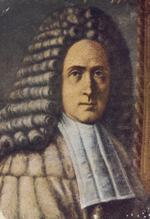Giovanni Battista Morgagni facts for kids
Quick facts for kids
Giovanni Battista Morgagni
|
|
|---|---|
 |
|
| Born | 25 February 1682 |
| Died | 6 December 1771 (aged 89) |
| Nationality | Italian |
| Known for | anatomical pathology |
| Scientific career | |
| Fields | anatomist |
| Academic advisors | Antonio Maria Valsalva |
| Notable students | Antonio Scarpa |
Giovanni Battista Morgagni (born February 25, 1682 – died December 6, 1771) was an Italian doctor who studied the human body. He is often called the father of modern anatomical pathology. This means he was the first to truly understand how diseases change the body's organs.
Morgagni taught thousands of medical students for 56 years at the University of Padua. His most important book, On the Seats and Causes of Disease, showed that most diseases start in specific parts of the body, like certain organs, not just spread everywhere.
Contents
Becoming a Doctor: Morgagni's Early Education
Giovanni Battista Morgagni came from a good family. At 16, he went to the University of Bologna to study philosophy and medicine. He earned his doctor's degree just three years later, in 1701.
He worked as an assistant to Antonio Maria Valsalva, a famous teacher. Morgagni helped Valsalva prepare his important book about the Anatomy and Diseases of the Ear. This book was published in 1704.
Morgagni's Career and Discoveries
Starting His Medical Journey
After Valsalva moved to another city, Morgagni took over his teaching role in Bologna. He was very respected there. At just 22, he became the leader of a science group called the Academia Enquietorum. He encouraged everyone to focus on careful observation of the body, rather than just abstract ideas.
In 1706, he published his first important book, Adversaria anatomica. This book made him known across Europe for his accurate studies of the body. It included his observations on the Larynx (voice box), the tear glands, and the pelvic organs in women.
A few years later, Morgagni moved to Padua in 1712. He was 31 years old. He taught medicine there with great success until he passed away in 1771.
Teaching and Fame in Padua
After three years in Padua, Morgagni was promoted to the important position of Professor of Anatomy. He followed in the footsteps of many famous scientists, like Vesalius. His salary was increased many times, showing how much he was valued. He married a noble lady from Forlì and had 15 children.
Morgagni was very popular. He was tall and dignified, with blonde hair and a friendly face. He was known for his polite manners and excellent Latin writing. Students from all over Europe came to his lectures. He was friends with important senators and cardinals, and even popes honored him.
He was elected to many important scientific groups, including the Royal Society in London (1724) and the Paris Academy of Sciences (1731). Some of his most famous students included Antonio Scarpa and Domenico Cotugno.
The Great Work: On the Seats and Causes of Disease
In 1761, when he was almost 80 years old, Morgagni published his most famous work. It was called De Sedibus et causis morborum per anatomen indagatis, which means "Of the seats and causes of diseases investigated through anatomy." This huge book, in five volumes, made pathological anatomy a true science. It changed how doctors understood diseases.
Before Morgagni, doctors didn't systematically study diseased organs. A book by Théophile Bonet in 1679, called Sepulchretum, was the first attempt. But it mostly focused on strange cases and wasn't always accurate.
Morgagni's book was different. He explained that he started writing it after a friend suggested he record his own observations. He wrote 70 letters about the anatomy of diseased organs. These letters became his famous book.
The book describes 646 dissections (studies of bodies after death). Morgagni carefully recorded the symptoms a person had while alive and then compared them to what he found inside the body after death. He included cases from his own work and from his teachers. This careful approach helped doctors understand that specific symptoms were linked to problems in specific organs.
Morgagni's Lasting Impact
Morgagni kept detailed notes from his medical consultations. These notes help us understand how he practiced medicine and how he described the body in the 18th century.
His work showed that doctors needed to base their diagnosis (identifying a disease), prognosis (predicting its outcome), and treatment on a deep understanding of what was happening inside the body. He was precise, thorough, and fair in his observations.
Morgagni's book marked the beginning of steady progress in understanding diseases. From then on, symptoms were seen as clues from suffering organs. This allowed doctors to develop a more scientific way of studying the natural history of disease.
Body Parts Named After Morgagni
Several parts of the body or medical conditions are named after Giovanni Battista Morgagni, honoring his contributions:
- Aortic sinuses ("Aortic Sinuses of Morgagni")
- Columns of Morgagni
- Foramina of Morgagni
- Hypermature cataract ("Morgagnian cataract")
- Hydatid of Morgagni
- Morgagni's hernia
- Morgagni Stewart Morel syndrome
- Sinus of Morgagni (pharynx)
Images for kids
See also
 In Spanish: Giovanni Battista Morgagni para niños
In Spanish: Giovanni Battista Morgagni para niños



